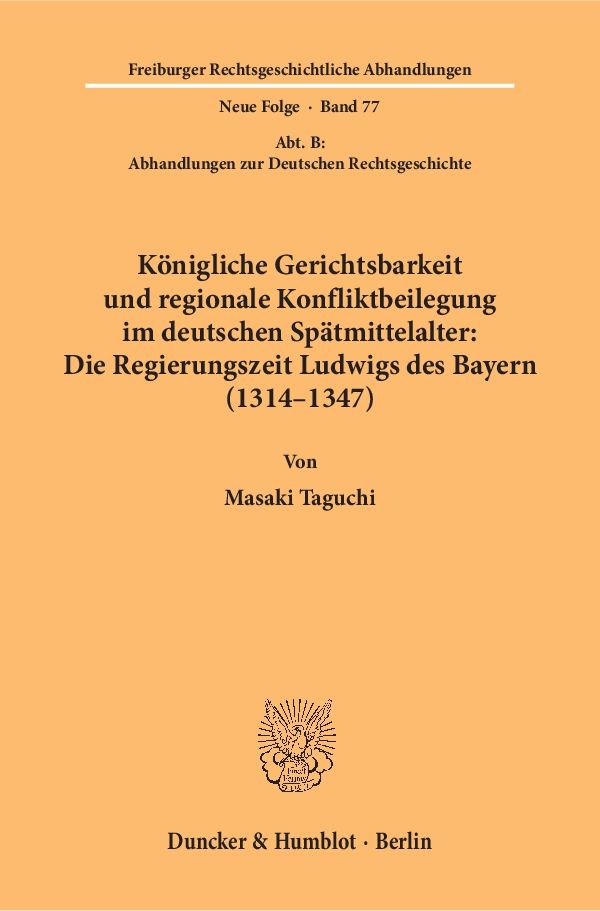
Title
Freiburger Rechtsgeschichtliche Abhandlungen, Neue Folge, Bd. 77, Abt. B: Abhandlungen zur Deutschen Rechtsgeschichte Königliche Gerichtsbarkeit und regionale Konfliktbeilegung Die Regierungszeit Ludwigs des Bayern (1314-1347)
Size
439 pages
Language
German
Released
2017
ISBN
978-3-428-14544-7
Published by
Dunker & Humblot
Book Info
See Book Availability at Library
Japanese Page
Since the 19th century, German Legal History studies have rated the German royal jurisdiction in the middle ages (from the second half of the 13th century to the 15th century) extremely poorly. Scholars state that the separation of the courts from the royal court was insufficient, their institutional development was poor, and their jurisdiction was limited because of the privileges that the monarchy afforded to the nobility and municipalities. In addition, there were insufficient means to realize judgments. However, these viewpoints evaluate the royal jurisdiction of the middle ages by modern standards.
In contrast to this, the fundamental idea of this book is to take various dispute resolution efforts from each region of Germany at that time as a backdrop in an attempt to understand the mechanics of royal jurisdiction. To this end, we shall select three regions (Central Rhine, Alsace-Upper Rhine, and North Rhine-Westphalia) from the time of King Ludvig IV in the first half of the 14th century. These historical contexts are most appropriate to examine and may likely show different types of relations between the monarchy and regions. We will then examine how disputes were handled among the main users of the royal court at the time, feudal lords, nobility and municipalities, through a wide-reaching observation of all types of documents, including unpublished historical materials.
Depending on the type of dispute and those involved in it, an attempt to resolve it may have been made in the feudal or ecclesiastical courts. However, arbitration based on agreement between the two parties was particularly popular, with detailed arrangements made regarding the selection of arbitration judges, the venue of arbitration, and the period within which arbitration would have to be made. Such attempts at conflict resolution did not emerge spontaneously but developed within structures whereby hegemonic feudal lords led the formation of regional order, ties between the nobility were connected by relatives, and alliances were regularly entered into between municipalities in each region. However, not all actors could exert decisive levels of influence, as those involved in the dispute could leverage their own power to resolve disagreements with the system in place.
This was the backdrop against which royal jurisdiction operated, with a strong arbitration function and difficulty imposing decisions on the parties of a dispute, similar to dispute resolution in the regions. Moreover, the meaning that royal jurisdiction held for the parties in disputes varied greatly based on the relationship history of the applicable region and the monarchy, such as the relationship between the hegemonic feudal lords and the king, the strength of the direct control exerted by the king, and how often the travelling royal court appeared in their area. While there were some regions where the negotiations and decisions of the royal court were commonly incorporated as a dispute resolution method among parties to disputes (Central Rhine), there were others that attempted to resolve disputes without reference to royal jurisdiction, unless it was a case that fell directly under the royal control (Westphalia). In this manner, while admittedly using only limited materials, we have attempted to reevaluate the royal jurisdiction of Germany in the late medieval period in a way that is more in line with how the world was constructed at that time, and not based on the judicial systems of modern nations.
(Written by TAGUCHI Masaki, Professor, Graduate Schools for Law and Politics / 2021)
Table of Contents
I. Die Zeit Ludwigs des Bayern
II. Königliche Gerichtsbarkeit im deutschen Spätmittelalter
III. Fragestellung und Quellen
B. Mittelrhein
I. Mittelrhein als historische Landschaft
II. Wege und Techniken der Konfliktbeilegung in der Region
III. Konfliktbeilegung im Mittelrhein-Gebiet: Strukturen, Beispiele und Entwicklungen
IV. Königliche Gerichtsbarkeit und regionale Konfliktbeilegung
C. Elsass und Oberrhein
I. Strukturen in der Region
II. Beispiele der regionalen Konfliktbeilegung
III. Königliche Gerichtsbarkeit und regionale Konfliktbeilegung
IV. Zusammenfassung
D. Westfalen
I. Strukturen in der Region
II. Konfliktbeilegungen in der Region
III. Berührungen mit der Königsgerichtsbarkeit
IV. Zusammenfassung
E. Schlussbetrachtung
Related Info
110th Japan Academy Prize (The Japan Academy April 6th, 2020)
https://www.japan-acad.go.jp/en/activities/jyusho/101to110.html#anker110
review:
reviewd by Hendrik Baumbach (Zeitschrift für Historische Forschung vol.44, No.4 2017)
https://www.jstor.org/stable/26647881?refreqid=excelsior%3A8e97896584d38788c96d5f0cba9a8930&seq=1#metadata_info_tab_contents



 Find a book
Find a book


 eBook
eBook